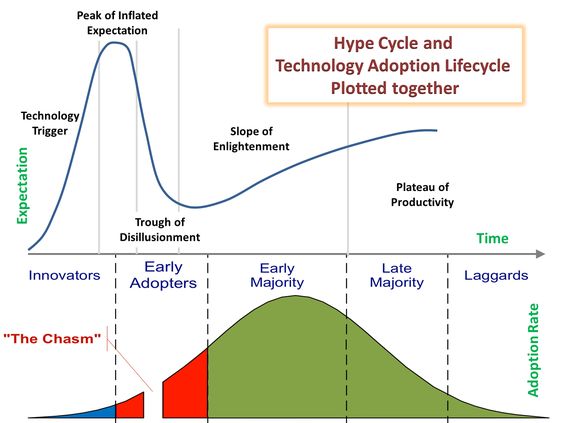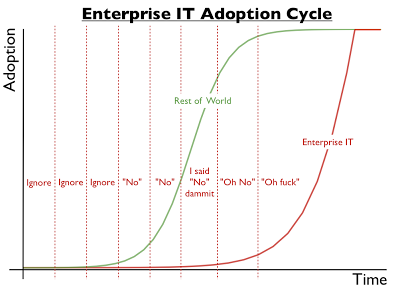Innovation sirens singing
In episode 13 of the Network Collective podcast around minute 26 Jordan Martin asks:
Aren’t we all just following a trend?
The discussion topic is how to mentor juniors in a learning path to grow their skills and be experts eventually.
The question can be translated as:
Are we creating fake (IT) news/trends or is it just (excessive) nerd enthusiasm?
Bloggers, events, news
Tech professional read every day about some new technologies promising to change the way we work, live and play. Nobody really needs/wants another blog post about Spanning Tree but STP is still here biting network engineers in the lower back and causing network meltdowns.
I admit I really enjoyed the Network Collective episode with Radia Perlman and how it is still relevant today - but you got the point.
Bloggers and journalists want to generate content, be part of the conversation, discuss the new trends and collect the rewards as Ad clicks, retweets, page views. It’s all about visibility a.k.a. feeding our egos unless it pays the bills, so it’s ego and money. I’m totally in this mechanism (totally but the money) and I’m not saying I’m innocent or this is something bad. I do blog, I do tweet, I do feed my ego with analytics.
But on the other hand we all give back to the community, we enjoy reading blogs of fellow network engineers, we learn from other experiences, it’s all free training after all! This is good!
Cum grano salis
Junior network engineers and tech enthusiasts can’t wait to put their hands on the new cool products and refresh the whole network around the new paradigm like SDN, SD-Wan, SD-Access, Intent-bases, Automation, Infrastructure as a code (should I continue?) and so on while posting Instagram updates of the unboxing process.
Fundamentals are not “cool”. They tell themselves there’s no time to learn protocols, packet formats, understand packet captures when so many shiny new products are on the news promising to fix everything with a new abstraction layer. (Rule 6 ).
The old grumpy engineer in the back of the room is adverse to any change, he keeps saying NO, he’s scared any innovation will make him jobless. Or not?
The hype cycle
Hype Cycle and Technology Adoption Life cycle are well known concepts, they make even more sense when plotted together:
What is missing here is the great amount of new technologies and paradigms that don’t survive the peak of expectation.
What happens if after the peak there is not a slope of enlightenment but a pit of despair for the early adopters who spent/wasted time and money?
If the product is just the new cool smart phone like a Windows Phone or a new crypto currency that fails it’s not a big deal. If the product is the Fabric on which you built your data-center or campus network you may be in trouble.
The Enterprise adoption cycle
Joe Drumgoole said a while ago:
The technology adoption route for IT departments: Ignore, prevent, tolerate, allow, integrate.
— Joe Drumgoole (@jdrumgoole) July 3, 2012
Translated by Simon Wardley in an image :
I think this is only partially true.
An Enterprise doesn’t want to adopt a new technology if it can’t be proved that it would have a positive impact on the business (read: revenues).
As I said in a previous post ,
More technology is not always good for the business.
New technology must prove it solves a real problem, not only moving it around creating a Complexity Sausage
3.4. The Complexity Sausage A frequent driver for the replacement of an established technology is a perception that the new technology is simpler and thus of greater economic benefit to the user. In an isolated system, this may be the case; however, as is usually the case with communications technologies, simplification in one element of the system introduces an increase (possibly a non-linear one) in complexity elsewhere. This creates the “squashed sausage” effect, where reduction in complexity at one place leads to significant increase in complexity at a remote location.
So what?
Bloggers and tech journalists will keep talking mostly about the new trends. Vendors will try to push new products that sometimes are only MVP or beta releases . Juniors will try follow the trends and feel disappointed when the seniors will slow down their enthusiasm.
We need a blogosphere for the 98% of people who aren’t close to the bleeding edge. Might not be sexy, but probably more valuable to industry
— Michael Bushong (@mbushong) October 20, 2017
Somebody will say Enterprise are dumb, slow or short sighted and get many likes/thumbsUp for such a great statement. The reality is there is a significant speed mismatch between the whole marketing/blogsphere desperately pushing for changes and the slower physiological rhythm of the Enterprise that needs more time to check the impact of the adoption of new products.
Some technologies are easier to implement than others. SD-Wan requires a change on the border routers while SD-Access requires new hardware and more control on the LAN. SDDC like NSX and ACI have an impact on the whole DC and need a migration that cal last months/years. But all those projects need an IT culture change, an Executive to sponsor, a PoC, a migration plan, testing, integration with 3rd party products.
Wrap up
Innovators are (mostly) unicorns in Silicon Valley. They need speed and have enough money and talents to move fast.
Early Adopters are Enterprises whose business runs fast or bad enough to make then able to accept more risks than others.
Most of us work in the Early Majority part of the curve and we like that because it means more time with our families, more sleep hours and less headaches.
I personally like to be informed about what’s happening on the far left side of the curve and I really enjoy blogging and discussing these topics. That doesn’t mean I’d like to have all these new technologies in production in networks I manage, but they would be very welcome in my lab!
We should try not to blame the companies that don’t jump on each new technology as soon as they’re public, nobody really cares about the Nascar slide .
In the meantime I advise the juniors I work with to keep studying the basics and not be distracted by all the sirens singing on blogs/articles in the sea of the interwebz .
Feedback
I’m always looking to improve and would love your feedback. If you spot any errors, have suggestions, or just want to share your thoughts, reach out to me directly on X.
Your input helps me make this blog better for everyone!
Support Ifconfig.it
If you enjoy the technical content I share and find it valuable, consider supporting the blog.


